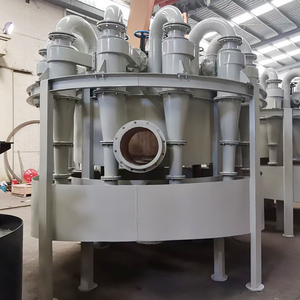(115 products available)
























































































































































A hydro cyclone separator is a device used for separating different phases, such as solid-liquid, solid-gas, liquid-gas, and liquid-liquid phases. They work on the principle of centrifugal force. Hydro cyclone separators come in different types, identified based on their structure, feed, apex, drain, or outlet configuration.
As noted, hydro cyclone separators may differ in structure and function. Below are some of the popular types of hydro separators widely used in different industries.
It is the most common hydro cyclone separator, which feeds from the top and has an overflow and underflow as the outlet section. This separator is effective for high concentrations of solids in liquids and works well for particles of different sizes.
A multi-cyclone separator has several smaller hydro cyclone separators in a single unit. This separator works well to increase the overall capacity. However, it lowers the cost compared to a single cyclone separator. This type of hydro cyclone separator can also be used to improve liquid hydro cyclone separators by adding more units in parallel.
A de-sander hydro cyclone separator is used to remove sand from drilling fluids (like water) in the oil and gas industry. Sand can impact drilling performance, therefore, affecting the life of the drill bit. By removing sand from drilling fluids, a de-sander hydro cyclone separator helps to improve the quality of drilling fluid, leading to improved performance and extended drill bit life.
De-sander hydro cyclone separators help to improve the performance and quality of drilling operations by extending the life of drill bits and reducing downtime. They achieve this by separating sand and other coarse particles from the drilling fluid, thus maintaining a stable and efficient drilling environment.
By removing oil from the drilling fluid, de-oiler hydro cyclone separators enhance the recovery of valuable drilling fluid, leading to reduced costs associated with the need for make-up drilling fluid. They also help to minimize environmental impact by reducing oil contamination in the cuttings and the treatment costs for handling contaminated solids.
Industry businesses need to know about application scenarios to find the best cyclone separator for their needs. A hydro cyclone separator has different models to suit diverse industry uses. Here are some typical industries where a hydro cyclone separator is used:
Mining and Mineral Industry:
The separator aids in the process of classifying, dewatering, and fine mineral extraction. It is a popular choice for the separator of gold, iron, copper, and coal from tailing.
Soil and Construction Debris Removal:
The vortex separator prevents soil from clogging drainage pipes. It allows only clean water to flow into the drain pipes. It is widely used in construction sites to collect soil from excavated land.
Pulp and Paper Industry:
A hydro cyclone paper separator removes fiber, filler, and other impurities in the pulp. It improves the quality of the pulp before processing into paper.
Cement Industry:
A cement cyclone separator distincts between fine cement particles and coarser ones. Fine particles enter the collecting bin whereas, coarse ones re-enter the grinding mill.
Oil and Gas Industry:
An oil cyclone separator extracts crude oil from water and sand particles. It also separates unwanted sand from the drilling fluid in the mud treatment system.
Water Treatment Plants:
A hydro cyclone water separator removes silt, sand, and other solid impurities from water. It improves the quality of water before storage or further treatment.
Food Industry:
A hydro cyclone separator is used to extract juice from fruits. It is also used to separate impurities from the fermentation process during liquor production.
Chemical Industry:
The hydro cyclone separator is used to separate chemicals, pigments, and other substances. It creates a more efficient production process and raises product quality.
When determining a reasonable price for the hydro cyclone separator, buyers must consider several factors, including the separator's features, market demand and competition, quality, and brand.
In conclusion, various aspects such as the hydro cyclone separator's features, quality, brand, market demand, and competition can impact the pricing. Buyers should consider these factors when choosing a hydro cyclone separator that meets their needs and budget.
Q1: How does a hydrocyclone separator work?
A1: The separator's structure and conical shape create a centrifugal force field that separates and classifies solid materials and liquids of different densities. Heavier particles settle down into the underflow, while lighter particles exit through the overflow.
Q2: What factors affect the hydro cyclone separator price?
A2: Generally, the hydro cyclone separator price will vary due to the sizes and capacities. Additionally, the separator's material and manufacturing process will influence the price. The separator with advanced technology will have a higher price.
Q3: What are the benefits of a cyclone separator?
A3: Separating particles from a fluid stream at high flow rates is one of the main benefits of a cyclone separator. Moreover, cyclone separators have no moving parts, meaning they can be low-maintenance and easily static.
Q4: What types of industries use hydrocyclone separators?
A4: A hydrocyclone separator is widely used in the mining industry, especially for ore classification and dewatering. It can separate valuable minerals from waste material, reducing water usage, so it's also popular in the petroleum industry.